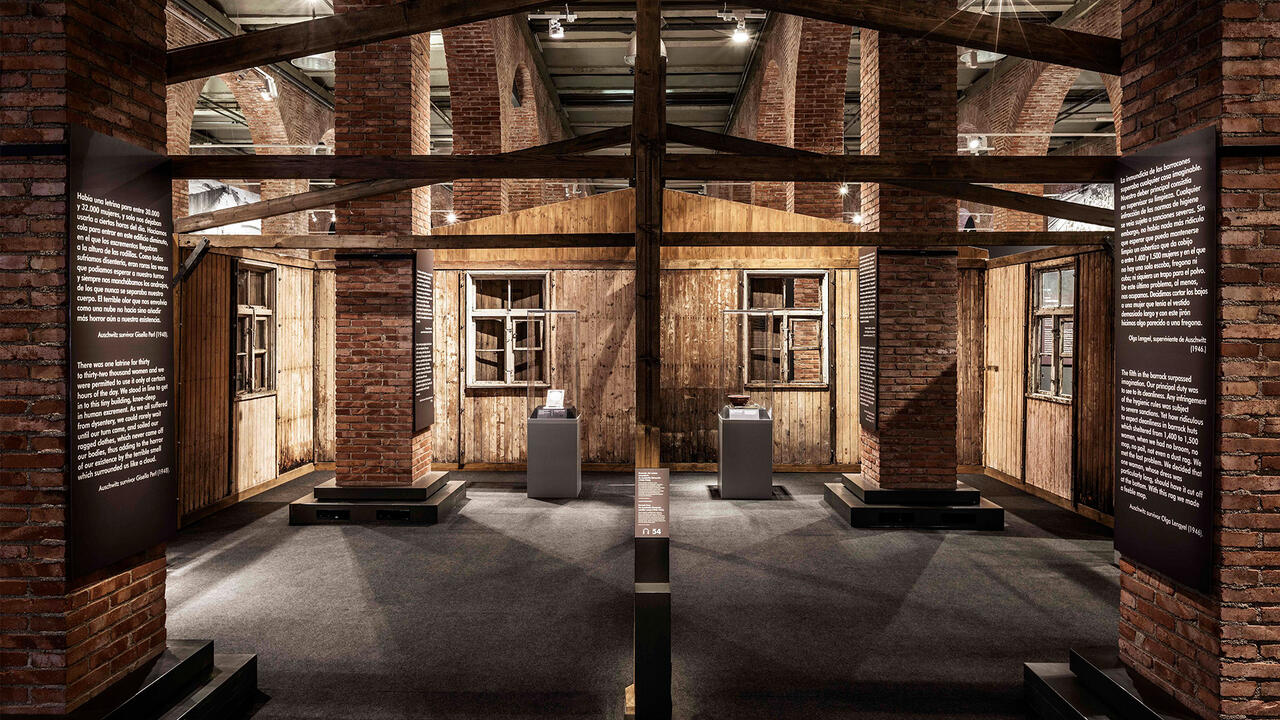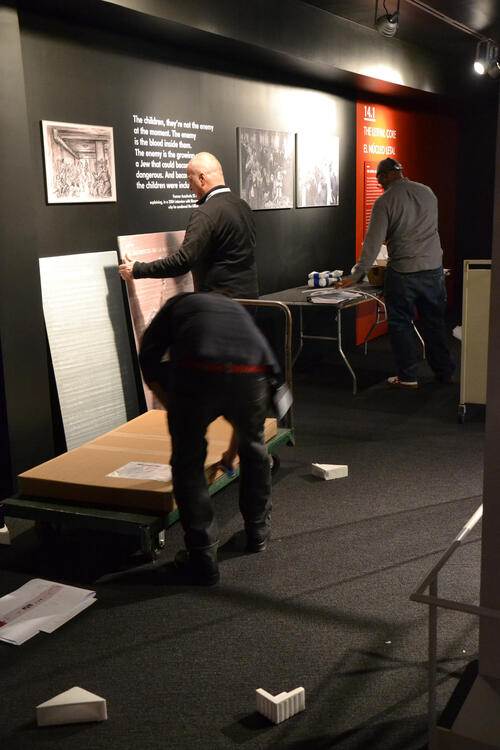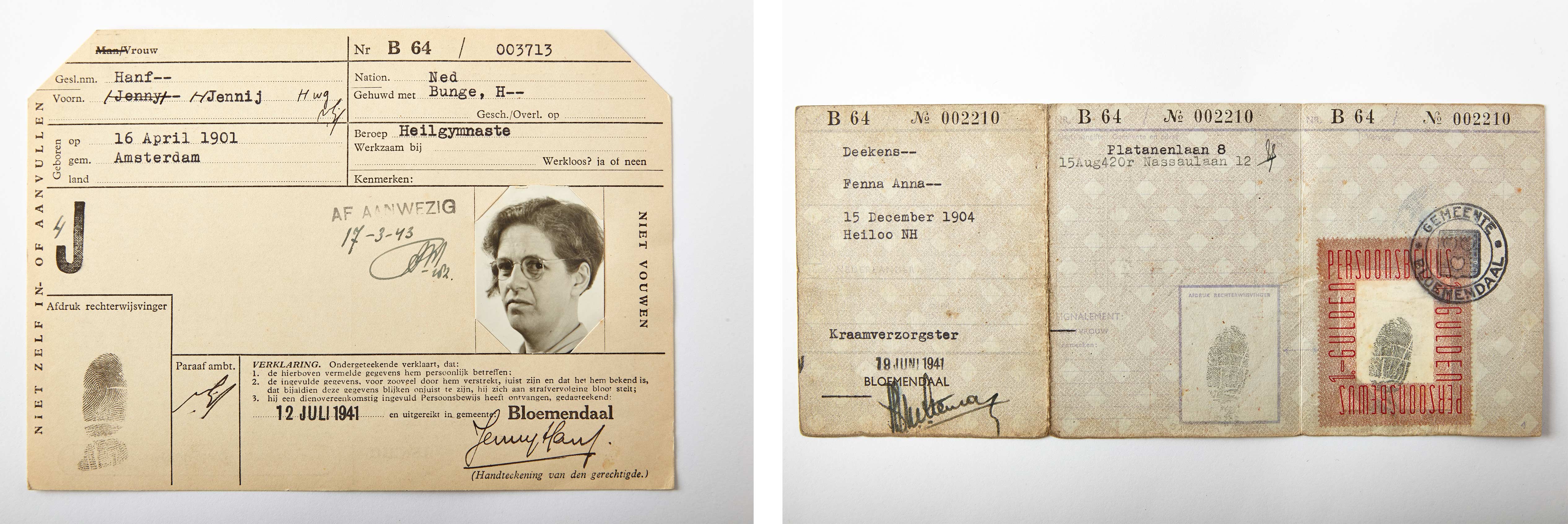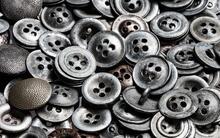
Waterloo connection to North America’s largest Auschwitz exhibit
Architecture professor and students share family artifacts and replica models in NYC

Architecture professor and students share family artifacts and replica models in NYC
By Carol Truemner Faculty of EngineeringRobert Jan van Pelt shares both a strong professional and personal connection to an upcoming New York City exhibit that tells the story of the unspeakable horrors of Auschwitz.

Robert Jan van Pelt (middle) installing New York exhibit.
The Waterloo School of Architecture professor is chief curator of Auschwitz. Not Long Ago. Not Far Away., a comprehensive exhibit dedicated to the history of Auschwitz and its role in the Holocaust. Featuring more than 700 original objects and 400 photographs from over 20 international institutions, the display is the largest of its kind in North America.
“Initially she went into hiding like Anne Frank. Then, through the resistance movement, she received false papers and a new identity,” says van Pelt, one of the world's leading experts on Auschwitz.
Hanf’s new identity helped her escape capture and detention in the Auschwitz concentration camp where over one million people lost their lives, including her brother, Robert.

Jenny Hanf's original Jewish registration card (left) and false ID (right).
van Pelt’s father-in-law survived Auschwitz and later became a tailor in the American forces. A housecoat he sewed with material found in a warehouse used to make SS uniforms will also be on display.
“It’s a symbolic object that tells the story of suffering, survival and making a new beginning,” says van Pelt.
The exhibit, which previously had a year-long run in Madrid, Spain, is the first to feature major loans of items from the former Nazi concentration camp in occupied Poland.
 Two of the dozens of items on loan are an original Auschwitz barrack and a windowless freight car similar to ones used for the deportation of Jews to the concentration camp. Smaller items include hundreds of personal items such as suitcases, buttons, eyeglasses and shoes found scattered in site excavations.
Two of the dozens of items on loan are an original Auschwitz barrack and a windowless freight car similar to ones used for the deportation of Jews to the concentration camp. Smaller items include hundreds of personal items such as suitcases, buttons, eyeglasses and shoes found scattered in site excavations.
Auschwitz. Not Long Ago. Not Far Away. also features 10 life-sized replicas, including key elements of a gas chamber.
Luis Ferreiro, director of Musealia, the Spanish travelling exhibition company that came up with the concept for the Auschwitz project a number of years ago, initially contacted a number of companies to create the models. He was unable to find one that could guarantee the required accuracy and quality.
“Professor van Pelt, our chief curator and historian, suggested working with a team of School of Architecture students,” says Ferreiro, who is also director of the exhibit. “This allowed him to oversee the whole production of plans and guarantee the historical correctness of the material.”
Two years ago, a number of Waterloo architecture students spent a co-op term in Madrid where they assembled the hundreds of parts they had produced at the School of Architecture. The students built the same models as well as many others for The Evidence Room, an Auschwitz installation that was part of the 2016 Venice Biennale and then at the Royal Ontario Museum for more than a year.
Ferreiro says the student-built models are some of the most memorable pieces on display.
“Visualizing elements of the camp is key to the visitor experience and understanding of the context in which Auschwitz developed,” he says.
The exhibit, which travelled by ship and courier across the Atlantic Ocean this spring, now fills all 25 sections of New York City’s Museum of Jewish Heritage, a building in view of the Statue of Liberty.
Intended to educate people about the atrocities of the Holocaust, Auschwitz. Not Long Ago. Not Far Away. opens on May 8 — the date of the Nazi surrender in 1945 — and will stay open until at least the beginning of 2020. Following the New York presentation, the exhibit will tour other cities around the world.
To manage the high volume of people expected to visit the Museum of Jewish Heritage, fewer tickets are available for each time period than there were in Spain.
“The biggest problem we had in Madrid was that people took twice as long to go through it as we anticipated,” says van Pelt. “So, we had to reduce the number of tickets because you can’t tell people to move on, especially at this exhibition.”

Read more
Velocity and FemTech Canada support Waterloo students to design transformative tech solutions for improving women’s health and well-being

Read more
The chancellor’s installation marks the formal appointment of a new leader to champion the University’s mission and vision

Read more
Waterloo Engineering grad from the School of Architecture turns talent for drawing into a flourishing academic career
The University of Waterloo acknowledges that much of our work takes place on the traditional territory of the Neutral, Anishinaabeg, and Haudenosaunee peoples. Our main campus is situated on the Haldimand Tract, the land granted to the Six Nations that includes six miles on each side of the Grand River. Our active work toward reconciliation takes place across our campuses through research, learning, teaching, and community building, and is co-ordinated within the Office of Indigenous Relations.